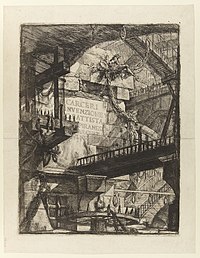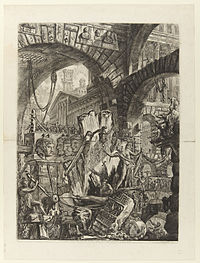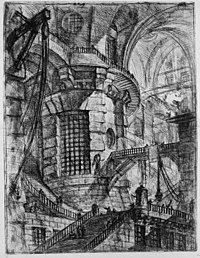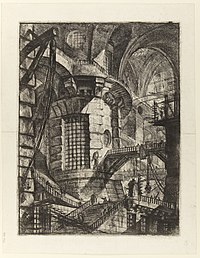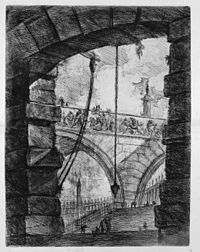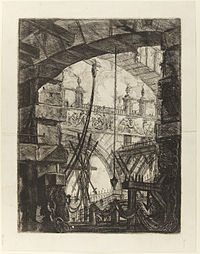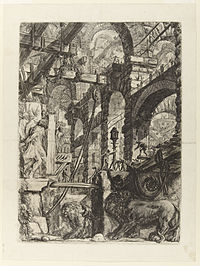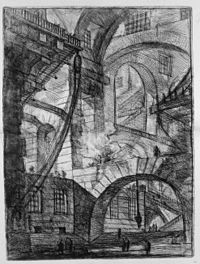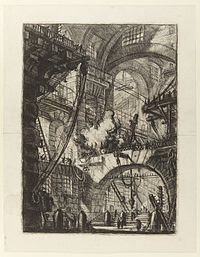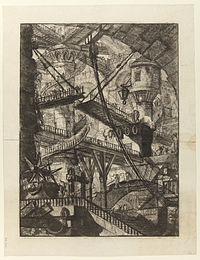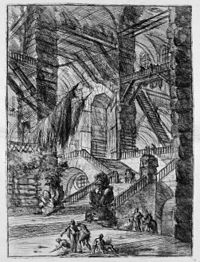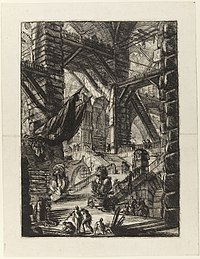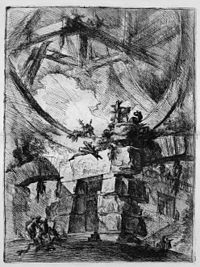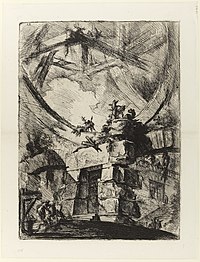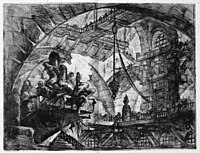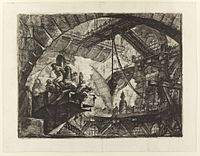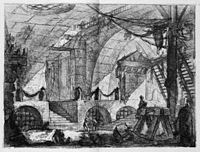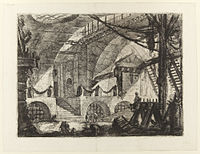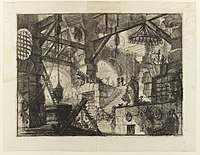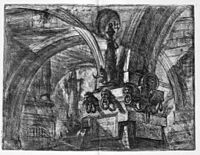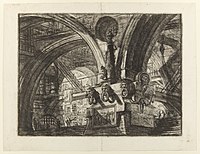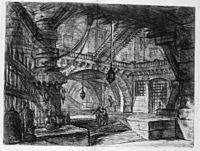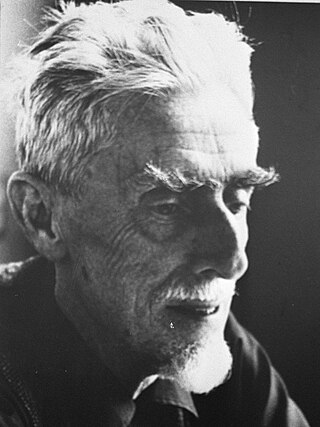
Maurits Cornelis Escher was a Dutch graphic artist who made woodcuts, lithographs, and mezzotints, many of which were inspired by mathematics. Despite wide popular interest, for most of his life Escher was neglected in the art world, even in his native Netherlands. He was 70 before a retrospective exhibition was held. In the late twentieth century, he became more widely appreciated, and in the twenty-first century he has been celebrated in exhibitions around the world.

Etching is traditionally the process of using strong acid or mordant to cut into the unprotected parts of a metal surface to create a design in intaglio (incised) in the metal. In modern manufacturing, other chemicals may be used on other types of material. As a method of printmaking, it is, along with engraving, the most important technique for old master prints, and remains in wide use today. In a number of modern variants such as microfabrication etching and photochemical milling, it is a crucial technique in modern technology, including circuit boards.

Giovanni BattistaPiranesi was an Italian classical archaeologist, architect, and artist, famous for his etchings of Rome and of fictitious and atmospheric "prisons". He was the father of Francesco Piranesi, Laura Piranesi and Pietro Piranesi.

Aquatint is an intaglio printmaking technique, a variant of etching that produces areas of tone rather than lines. For this reason it has mostly been used in conjunction with etching, to give both lines and shaded tone. It has also been used historically to print in colour, both by printing with multiple plates in different colours, and by making monochrome prints that were then hand-coloured with watercolour.

Brian John Peter Ferneyhough is an English composer. Ferneyhough is typically considered the central figure of the New Complexity movement. Ferneyhough has taught composition at the Hochschule für Musik Freiburg and the University of California, San Diego; he teaches at Stanford University and is a regular lecturer in the summer courses at Darmstädter Ferienkurse. He has resided in California since 1987.
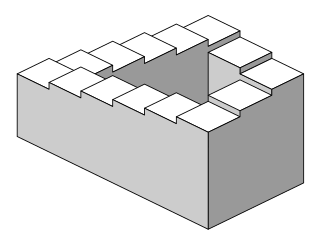
The Penrose stairs or Penrose steps, also dubbed the impossible staircase, is an impossible object created by Oscar Reutersvärd in 1937 and later independently discovered and made popular by Lionel Penrose and his son Roger Penrose. A variation on the Penrose triangle, it is a two-dimensional depiction of a staircase in which the stairs make four 90-degree turns as they ascend or descend yet form a continuous loop, so that a person could climb them forever and never get any higher. This is clearly impossible in three-dimensional Euclidean geometry but possible in some non-Euclidean geometry like in nil geometry.
Monoprinting is a type of printmaking where the intent is to make unique prints, that may explore an image serially. Other methods of printmaking create editioned multiples, the monoprint is editioned as 1 of 1. There are many techniques of mono-printing, in particular the monotype. Printmaking techniques which can be used to make mono-prints include lithography, woodcut, and etching.

The etching revival was the re-emergence and invigoration of etching as an original form of printmaking during the period approximately from 1850 to 1930. The main centres were France, Britain and the United States, but other countries, such as the Netherlands, also participated. A strong collector's market developed, with the most sought-after artists achieving very high prices. This came to an abrupt end after the 1929 Wall Street crash wrecked what had become a very strong market among collectors, at a time when the typical style of the movement, still based on 19th-century developments, was becoming outdated.
Inspired by Bach, a part of Sony Classical celebrates Bach, presented the contemporary cellist Yo-Yo Ma performing the six Suites for Unaccompanied Cello by Johann Sebastian Bach, in a series of six films, each showing a collaboration with artists from different disciplines.
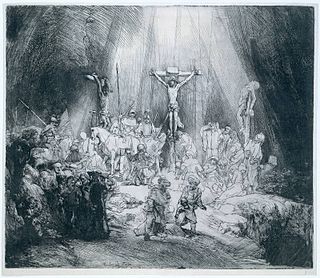
An old master print is a work of art produced by a printing process within the Western tradition. The term remains current in the art trade, and there is no easy alternative in English to distinguish the works of "fine art" produced in printmaking from the vast range of decorative, utilitarian and popular prints that grew rapidly alongside the artistic print from the 15th century onwards. Fifteenth-century prints are sufficiently rare that they are classed as old master prints even if they are of crude or merely workmanlike artistic quality. A date of about 1830 is usually taken as marking the end of the period whose prints are covered by this term.
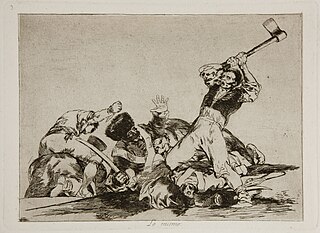
The Disasters of War is a series of 82 prints created between 1810 and 1820 by the Spanish painter and printmaker Francisco Goya (1746–1828). Although Goya did not make known his intention when creating the plates, art historians view them as a visual protest against the violence of the 1808 Dos de Mayo Uprising, the subsequent cruel war that ended in Spanish victory in the Peninsular War of 1808–1814 and the setbacks to the liberal cause following the restoration of the Bourbon monarchy in 1814. During the conflicts between Napoleon's French Empire and Spain, Goya retained his position as first court painter to the Spanish crown and continued to produce portraits of the Spanish and French rulers. Although deeply affected by the war, he kept private his thoughts on the art he produced in response to the conflict and its aftermath.

William Blake's Illustrations of the Book of Job primarily refers to a series of twenty-two engraved prints by Blake illustrating the biblical Book of Job. It also refers to two earlier sets of watercolours by Blake on the same subject. The engraved Illustrations are considered to be Blake's greatest masterpieces in the medium of engraving, and were also a rare commercial and critical success for Blake.

In the dull village is an etching and print made by David Hockney in 1966, one of series of illustrations for a selection of Greek poems written by Constantine P. Cavafy. It depicts two men lying next to each other in bed, naked from the waist up, with their lower halves covered by bedclothes.

The Hundred Guilder Print is an etching by Rembrandt. The etching's popular name derives from the large sum of money supposedly once paid for an example. It is also called Christ healing the sick, Christ with the Sick around Him, Receiving Little Children, or Christ preaching, since the print depicts multiple events from Matthew 19 in the New Testament, including Christ healing the sick, debating with scholars and calling on children to come to him. The rich young man mentioned in the chapter is leaving through the gateway on the right.
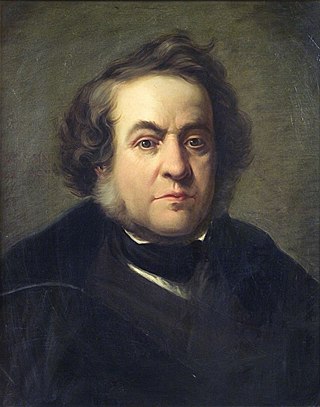
Luigi Rossini (1790–1857) was an Italian artist, best known for his etchings of ancient Roman architecture.

The Liber Veritatis, meaning Book of Truth in Latin, is a book of drawings recording his completed paintings made by Claude Lorrain, known in English as "Claude". Claude was a landscape painter in Rome, who began keeping this record in 1635/6, as he began to be highly successful, and maintained it until his death in 1682. The book is now in the British Museum, and was owned by the Dukes of Devonshire from the 1720s until 1957. It was reproduced in print form from 1774 to 1777 by Richard Earlom and had a considerable influence on British landscape art. The title Liber Veritatis was apparently invented for these reproductions, but is now also used for the original.
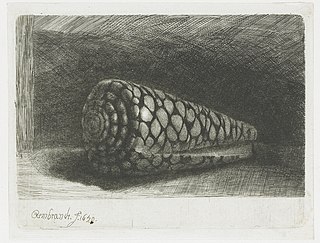
The Shell, also known as Rembrandt's Shell or Conus Marmoreus, or in Dutch as De schelp or Het schelpje, is a 1650 drypoint and etching by Rembrandt van Rijn. Catalogued as B.159, it is Rembrandt's only still life etching. Only a handful of original prints are known, in three states.
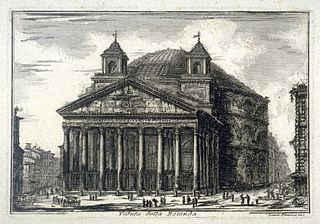
Laura Piranesi (1754–1789) was an Italian etcher working in Rome towards the end of the 18th century. She was an active participant in her family's print workshop, run by her father Giovanni Battista Piranesi, an Italian artist, etcher, and antiquarian. Participating in the veduta genre, Laura's prints consist of stylized views of Roman architecture and ruins that aim to capture the spirit of the city through landscapes. Vedute and architectural prints were particularly popular among travelers participating in the Grand Tour, and as Laura lived and worked during the height of the Grand Tour, her prints catered to the souvenir market. Her use of chiaroscuro and free-flowing lines reflect the rising popularity of Romanticism, which prioritizes emotion over accuracy.
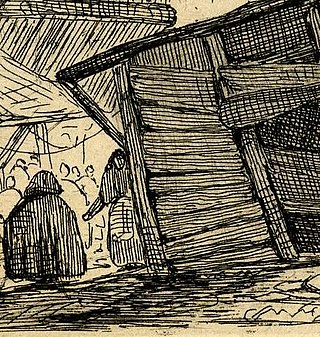
In printmaking, surface tone, or surface-tone, is produced by deliberately or accidentally not wiping all the ink off the surface of the printing plate, so that parts of the image have a light tone from the film of ink left. Tone in printmaking meaning areas of continuous colour, as opposed to the linear marks made by an engraved or drawn line. The technique can be used with all the intaglio printmaking techniques, of which the most important are engraving, etching, drypoint, mezzotint and aquatint. It requires individual attention on the press before each impression is printed, and is mostly used by artists who print their own plates, such as Rembrandt, "the first master of this art", who made great use of it.
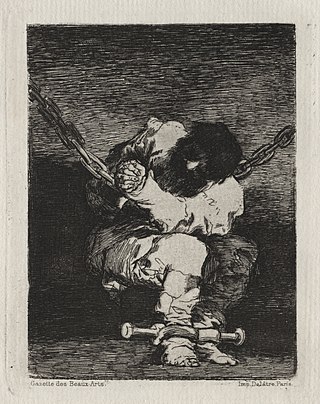
The Prisoners is a series of three etchings by Francisco de Goya, depicting imprisoned men with indistinct faces, bound with leg irons in stress positions. The prints are not dated, but they are believed to have been made between 1810 and 1815, around the time Goya started his print series The Disasters of War. Political considerations made it impossible for Goya to publish the prints during his lifetime.


